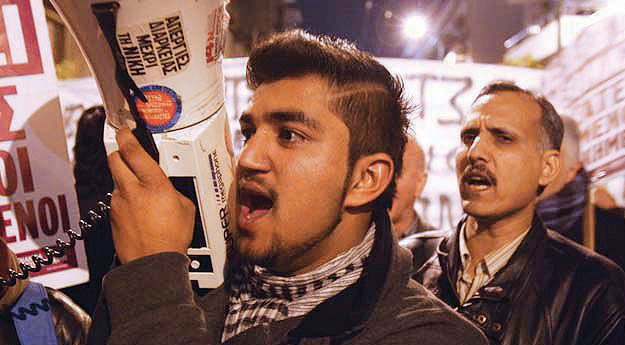
Golden Dawn, with its anti-immigrant and rabidly nationalist agenda has been linked to attacks on immigrants across Greece but this seems to have only increased its appeal among a fed-up populace whose fortunes seem to be steadily declining. In the 2012 elections, the Golden Dawn received 7% of the popular vote, allowing it to enter parliament with 21 seats. As long as economic turmoil continues to engulf Greece, its support base is set to strengthen. In this phenomenon, Greece is by no means unique. From Italy’s Northern League to France’s National Front, the European right is very much on the rise. But while Xenophobia may be a Greek word, and Italy the birthplace of modern fascism, it is Germany that lays claim to the poisonous legacy of Nazism. In an ironic turn of events, it now seems that Golden Dawn’s members are setting up cells in German cities to recruit Greek immigrants to their cause. But while the rest of Europe lurches to the right, what is the situation in Germany itself?

“He is immortal who lives through his children and his children’s children. Do you want to be an immortal?” The question stands out in bold white letters set against a black background. This is the website of the Immortals, a neo-Nazi group in Germany which has built up a formidable reputation by organizing flash mobs in German cities, largely by tapping the mobilizing power of social media.
In May 2011, one such impromptu march in the eastern German town of Bautzen was captured on video. The footage shows several hundred people walking down the street wearing black cloaks, their faces covered with identical white masks. They waved fiery torches above their heads — quite like the members of the Ku Klux Klan (KKK) whose pointed headgear and white cloaks and sent shivers down the spines of the ‘coloreds’ in the USA in the 1960s.
Recently, German authorities launched an investigation into an accusation that two police officers in Munich had recently become members of the German branch of the KKK. To add to the scandal, these officers were also a part of an investigation into a series of murders committed by the so-called ‘Zwickau cell’ of the National Socialist Underground — a right-wing terror group from eastern Germany that was busted in late 2011, after two of its members were found dead in an apparent suicide pact.

The group, headed by Beate Zschaepe, had been active since 2001, and was responsible for the killings of nine immigrants as well as several bank robberies. For investigators and observers, a link between the rise of neo-Nazism and regions of the erstwhile German Democratic Republic (GDR) seems to be slowly emerging.
The relative economic disadvantages experienced by several regions that were formerly part of East Germany also seem to be fueling the right-wing scene. Ideological totalitarianism during the communist regime in the GDR seems to have also contributed to the identity crisis of the youth in these areas, a factor which has been extensively addressed by neo-Nazi ‘dropout’ Ingo Hasselbach in his book, Fuhrer-Ex: Memoirs of a Former neo-Nazi. Several youth in these areas have had parents who were complete believers in the communist system until the Berlin Wall fell in 1989, leading to confusion and a deep loss of faith. Consequently, there were those who sought refuge in ‘ethnic’ pride and hailed this characteristic as the primary form of identification with the German nation.
The skinhead movement existed in both the GDR and West Germany even before the reunification of Germany. However, as Andreas Hieronymus from the Institute for Migration and Racism Research (IMiR) in Hamburg says: “After reunification and the breakdown of the government in the East, western Nazis could contact existing structures in the East and they used it as a recruiting field… In the east the communist ideology had broken down and nationalism was reinforced, but how German nationalism could be articulated without referring to the fascist time was not clear.”
Fading into the crowd
Neo-Nazi groups in Germany, like the Immortals and Autonomous Nationalists, have a lively sub-culture, complete with its own music and mode of dressing. Several groups make an effort to blend into the population, enjoying Turkish food and avoiding the typical skinhead look. They are also active on the internet, especially Twitter, where they communicate with fellow group members and organize instant mobs.
But how much traction do the right-wing extremists actually find in Germany? Is there a link between economic downturn and the rise in right-wing extremism as in the case of Greece and Golden Dawn?
Prof. Wilhelm Heitmeyer, an expert on right-wing extremism contends that right-wing extremism as an organised political movement does not stand a chance despite high levels of unemployment in the Ruhr area in Germany. “These are groups which do not operate as political parties. Instead they, like the Autonomous Nationalists, are instead known for their violent tactics and also for their links to the murderous National-Socialist Underground,” he says.

Heitmeyer claims that the prospect of right-wing parties becoming more popular is far lower in Germany than in Poland or Hungary where extreme right political parties could win at the national level, even though they may not use violence the way the ‘genuine’ right-wing extremists do. This could in fact be a bigger problem for democracy.
Tough questions
In Germany, right-wing groups pose a threat to the weaker sections of the population, such as migrants. A recent study by the Friedrich Ebert Foundation, a German think tank, confirms this. The authors claim that the perceived hate against foreigners is a strong motivation for prospective members to join right-wing groups. Islamophobia, too, is closely linked with the anti-immigrant sentiments that prevail and the general fear of the ‘other’ that seems to fuel anti-Muslim feelings as well. The same study claims that right-wing views have gained more support in Germany in recent years. In 2010, right-wing extremist views were believed to be present among 8.2 per cent of the population; today the figure has risen to 9 per cent.
In a paper called, Is Europe on the ‘right’ path, Britta Schellenberg, an expert on right-wing extremism in Germany, believes that neo-Nazi groups try to win support using migrant issues, especially at the local level. However, none of the right- wing groups have ever been able to establish themselves nationally because of strict German laws governing the constitutional validity of such organizations. Organisations such as the Antifaschisten (anti-fascists) are also militantly active in the anti-right wing scene in Germany. They have also organized counter-marches to protest Neo-Nazi demonstrations.
A strong democracy and a vibrant anti-fascist movement have proven a bulwark against what are fundamental changes in Germany’s demographics, but there is still a long way to go before the pereption of what it means to be ‘German’ changes.
Hieronymus believes that this “reinvention” is happening, but it will take a long time: “Our citizenship law was changed just about 12 to 13 years ago and until then you had this definition of a pure German being an ethnic German, but now you can be a German if you are an ethnic or a migrant, naturalized German. Slowly, the images of a black German or a Muslim German begin to emerge. But still, when people think of a German, they think of a blond, blue-eyed person.”
Germany’s public sphere today is dealing with the debate on the basic identity of its country — with ‘who is a German?’ being the most important question. And it is at this junction where right-wing extremism clashes with the integration of foreigners into what is essentially a western democratic culture with Catholic roots and a strong sense of identity.
Published in The Express Tribune, Sunday Magazine, March 10th, 2013.
Like Express Tribune Magazine on Facebook to stay informed and join the conversation.
COMMENTS (17)
Comments are moderated and generally will be posted if they are on-topic and not abusive.
For more information, please see our Comments FAQ

1731637727-0/Bear--(1)1731637727-0-165x106.webp)

1731619853-0/ice-cream-(1)1731619853-0-165x106.webp)













@Manasi Gopalakrishnan: Roots, when used for a people, mean ethnic and cultural origins. This is why the Germans have enshrined their pre-Christian culture with monuments to the likes of Hermann in Teutoburg forest and in Minnesota. Even the origin of the Christmas tree goes back to Yggdrasil and Thor's Oak. By ignoring such facts and claiming Germanic culture is "...essentially Catholic roots," you are hawking ensuing developments as the foundation.
@Manasi Gopalakrishnan: Well said! The capital of the Habsburger empire was in Wien, which was under Siege of the Ottomans twice, which was later lifted at the request of the Habsburger Monarch who agreed to pay trbutes.
Rex Minor
@Pessimist: I do not mean to be rude to Marco Polo traveller of Europe, nor am I going to accept extreme right for one or other reason. Those who practice this are " Rat Catchers" populists to play with the emotions of the people. The conservatives as well the liberals of some countries participate in such campaigns.
Kinder (children) instead of Inder (Indian) was the slogan of a former Premier of the largest Province in Germany in the campaign. This is a garbage language and is not acceptable.
The Europeans have never had an open immigration policy for any but this did not prevent the people of colonies settling down in Europe or those who conquered Europe and became part of it. This includes Indian (hindu and muslim) immigration into UK as well as the north African muslims in France. The industrial complex of the french and the German republic as well as its infrastructure after its destruction in ww2, needed skilled and unskilled labour and this came rom Turkey and North Africa, and in the case of France from their African colonies. Those who have worked in the mining and steel industry or those who are working on the assemby lines of BMW, Ford, Mercedes, Opel and VW are not living on welfare but contribute to welfare. There is the need for complete integration into host country's culture, and this remains a task. Both the Jewish and muslim communities are the integral part of the European identity but not fully acceptable to the extreme right. Not yet atleast, until the demographics alter.
For ghettos, you wil need to travel to USA!!
Rex Minor
Sobriquet: The Holy Roman Empire had its capital in Aachen, Germany in the 15th century and was closely connected to the Pope. Martin Luther was exactly against this kind of connivance between the church and the state. And without any Catholic roots, protestantism wouldn't be there. Today, Cologne is one of the largest Diocese in the world after Rome. Several German states are predominantly catholic with a strong sense of tradition.
@Pessimist: @Stan: Please read the first sentence of Kailash's comment: "Why no body write anything about vanishing population of minorities in Mus lim countries. " May I ask how your comments respond to that query?
Pakistanis should stay away from EU. Lets not forget they should also stay away from US and North America, as there are many Right Wingers or what you people so lovely referred to as Neo Cons.
There are 57 Ummah affiliated countries anyway.
@Pessimist: As always a balanced post. Welcome back. Haven't seen you in a bit.
The rise of extreme right wing parties across Europe is a matter of concern but Muslims are hardly innocent angels in this matter. I've been in Europe for the past three years and I've done some considerable travelling.
Across every major city in Europe (Paris, Berlin, Brussels etc), Muslim immigrants from Arab & north African countries have migrated in large numbers and are living in ghetto type conditions. Most of them are on some type of welfare so they are hardly contributing to the economy. The unemployed youth indulge in anti-social activities and there's been an increase in crime in those areas, with religious extremism also on the rise. With such facts, can you blame the rise in extreme right wing parties?
For Kalaish Setthy: This article was written by an Indian so I don't know why you are complaining. Sadly, Indians, Greeks and immigrants from Eastern European countries (Romania, Poland etc) have also been victims of hate crime.
The articles deals with the growing Nationalism and extreme right in most European countries for a number of factors including the growin unemployment in unskilled labour sector, immigration from non-european countries. This is not a new phenomina, The majority of Euroeans are reliigous and strongly to right, The so called conservative and christian democratic parties and some liberal parties regularly flirt with extremism during election campaigns.
Rex Minor
So concerned about intolerance in Greece. All well in Pakistan on this front I guess?
@Kailash Sethy: If you visit this site regularly, you would see blogs and articles in support of women and religious minorities and critical of conservative and far-right political parties in Pakistan, your comment comes off as ignorant since you choose to ignore the countless blogs written by many Muslims and non-Muslims on this site against extremists, in fact some times people get labeled as "liberal fascists" here.
Second of all this article was written by an Indian not a Pakistani, and your comment is irrelevant to the subject, if you want to comment about what's going on in Pakistan then you should post comments on blogs related to what going on over here.
Lastly the rise in xenophobia in Europe isn't just directed towards Muslim migrants but also towards non-Europeans of all religions even Christians.
What goes around, comes around.
Multiculturalism is to Europe, what colonialism was to all the 'colored' nations.
Why no body write anything about vanishing population of minorities in Mus lim countries. Why there is no or very little liberal voices talking about rights of minorities and women in these nations. Instead of that blaming west always what purpose it solves. Is it that west who gives equal rights to all its citizen will be held to higher standards and these mus lim countries who r still in medieval age are not fit to these modern standards? So no equal right to women and minorities in these countries are acceptable. Talk of hypocrites!
The authour shows his ignorance when he claims that being German is "...essentially a western democratic culture with Catholic roots..."
Why? Because being German essentially implied being Germanic in language and beliefs. The pluralistic thought that was one of the core elements of pre-Christian Germanic beliefs, eventually led to Martin Luther's German-led Protestant Reformation that broke the monopoly of the Catholic Church.
Germany and several of the Germanic-derived cultures, such as The Netherlands, Scandinavia and England (Anglo-Saxon) are secular and democratic because of this 'German' reformation of the 'Catholics'. These countries are also the most open to other religions. So is this what the author means by 'culture with Catholic roots' ?
New Nazis are every where in Europe